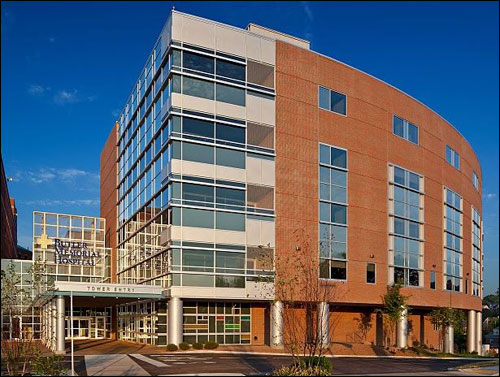When Butler Health System (BHS) planned its construction of a 210,000-square-foot surgical tower as an addition to its existing 330,000-square-foot hospital—known as Butler Memorial—it began reviewing real-time location systems (RTLS) that could capture the location of surgical patients and share that information with the staff and visiting family members. The envisioned solution would communicate with visitors regardless of where they are located within the hospital (both in the new tower and in the original facility) while waiting for a loved one undergoing surgery, and enable them to receive an alert as that patient’s status changed—such as entering or leaving the operating room (OR) or the post-operative unit. In addition, the hospital wanted the system to tie into its voice-over-IP (VoIP) communication system with nurses and physicians, so that they, too, could view the location and status updates of patients to whom they are assigned, and thus improve OR workflow and be better able to respond quickly when necessary.
Chuck Oleson, BHS’ VP and chief information officer, met with RTLS solutions provider Intelligent InSites. The system that Butler and Intelligent InSites designed employs RTLS hardware from Ekahau, leveraging both Wi-Fi and infrared (IR) technology to locate a patient wearing a tag within the hospital. Intelligent InSites’ InSites Enterprise Visibility Platform software captures tag-location data from the Ekahau system, and makes that information available to visitors with Ekahau badges via the Wi-Fi network, as well as to a nurse communication system provided by Vocera Communications. By integrating the phone system with the RTLS data, the system can automatically send text messages via VoIP to employees’ phones, whenever a patient’s location, and thus, status, changes. The system went live when the tower opened, in August 2010, with 200 tags for patients and visitors.

The hospital is also using the new tower’s RTLS to track the locations of mobile assets and the temperatures inside coolers and warmers. “Communication of OR patient status was the priority for us,” Oleson states. “We were focused on the clinical quality of care we could provide our patients with technology.” The tracking of assets, he says, as well as the temperatures of refrigerators, freezers and blanket warmers, was a secondary priority.
Butler’s RTLS deployment comprises three types of Ekahau tags. In the case of patient and visitor tracking and communication, the hospital is utilizing T301BD tags with built-in dual IR and Wi-Fi technology. A patient can clip his or her T301BD badge tag onto clothing, while visiting friends and family members can carry the same model tag, married to that patient’s ID number in the software. A total of 145 IR location beacons, each emitting a signal carrying that tag’s serial number, were installed throughout the new hospital tower. So far, the beacons have been installed only in the new tower, in order to target the locations of patients within the new OR facility.
The badge tag of each patient or visitor captures the serial number of the IR beacon within its range, and then transmits a 2.4 GHz signal containing that beacon’s serial number, as well as its own unique ID number, to the hospital’s back-end system. In some cases, the system utilizes Room Beacons that flood an entire patient room with its IR signal. A Bed Beacon is used to create microzones, such as an area comprising one patient bed in a larger room. In this case, explains Tuomo Rutanen, Ekahau’s senior VP of marketing and business development, the IR coverage area is approximately one foot by one foot. The Ekahau software then calculates the patient’s location, based on the Wi-Fi node that received the signal of that individual’s badge tag and the IR sensor’s serial number. The tag’s unique ID is linked in InSites’ software with data input about the patient, including that person’s name, planned procedure and location.
As the patient is moved from pre-op to the operating room, the system detects that transition and sends an update to the InSites software. An update regarding the patient’s status is then transmitted to the visitor’s Ekahau badge, in the form of a text message. Similarly, a text message can be sent to the phone of any appropriate staff members. When that individual leaves the OR for the post-anesthesia and then post-operative rooms, says Carol Tweten, Intelligent InSites’ director of product management, a new message is sent to the badges of that person’s loved ones, as well as to the staff’s Vocera phones.
The location data is also displayed on video monitors installed in waiting areas on three of the tower floors. In this case, the patient’s ID number is displayed, but not his or her name, in order to protect that individual’s privacy. The hospital also installed video monitors at nursing stations that list the same information, along with the operations schedule for that day.
The benefits for patients and their loved ones is the greater mobility that the Ekahau badge provides. Without the system, visitors may feel obligated to remain close to the OR to receive updates about the patient’s status. But with the badge, visitors can instead walk throughout the hospital, visit the cafeteria or stroll the street outside, as long as they remain within range of a Wi-Fi node.
The asset-tracking system uses Ekahau T301A tags that employ Wi-Fi technology only, without infrared sensors. The hospital has attached the tags to high-value items that often end up missing, such as infusion pumps and glucose monitors. A T301A tag is attached to each asset, and beacons its own ID number at preset intervals.
The InSites software allows employees to log into the system and view a map of the hospital, with icons indicating where each item is located. Approximately 200 tags have been applied to assets, and Oleson says more will be tagged in the future. Although Butler has yet to measure the system’s benefits, Oleson says staff members have told him that it has prevented equipment shortages often resulting from workers “hoarding” devices to ensure they are available when needed, thereby making them difficult to locate.
The temperature-monitoring Ekahau T301t tags come with temperature sensors, Rutanen says, and are used within coolers and warmers to provide regular temperature readings, as well as alerts in the event that a temperature falls outside the acceptable threshold. Prior to the system’s installation, Oleson notes, employees manually checked thermometers on appliances on an hourly basis. With the Ekahau system, he estimates, the hospital saves approximately 60 hours of time in which the staff previously checked and recorded temperatures—time that they can now use to provide health-care services to patients.
The integrated RTLS and VoIP solution is working well, Tweten says, adding, “We did a lot of planning up front, and Butler had a very good training program in place.”


